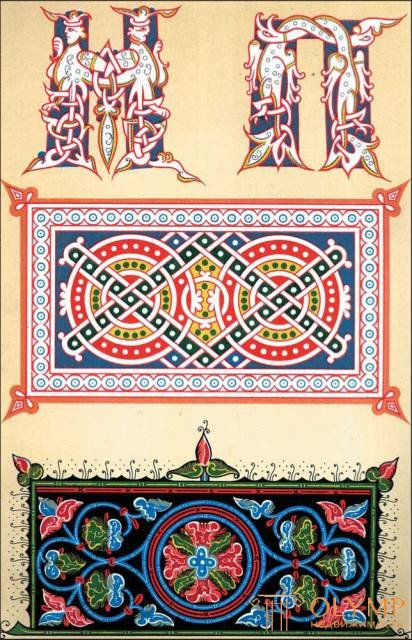
In Russia, as in Persia and China, the Tatar-Mongol yoke also had a leveling effect in the Asian spirit. Chinese, Indian, and especially Persian art flowed in a wide stream through the floodgates opened by the Tatar-Mongol sovereignty to the vast artistic plain of Russia, plowed by Byzantine art. During the period of the conquest of Persia by the Tatar-Mongols, the Muslim architecture of that country assimilated its own peculiar forms (see t. 1, fig. 657), from which our attention was particularly attracted by wide keeled arches and, accordingly, curved, bulbous or pear-shaped domes. It is these forms that are now rooted on Russian soil. St. George's Church in Yuryev-Polsky (1234) has a keel-shaped arch of its portal, heart-shaped or bulbous, with a dome and relief relief arabesques covering the entire facade already resembling Asian buildings (Persian prototypes), and in the Assumption Cathedral in Zvenigorod the arch-shaped arches in the Assumption Cathedral in Zvenigorod even crowned the facade instead of old semi-circular arches. arches.
At the expense of the Asian influence should also include a variety of coloring roofs and heads of Russian churches. Preference is given to green, red and white paints, to which gilding more and more often joins domes. A five-dome system was borrowed from Byzantium (see Fig. 25 and 60); It is surprising that she appeared in Russia only in this era. Along with the five-dome system there is also a greater number of domes. From the Asian elements it is picturesque, but not to say organically, merged with the Slavic artistic taste, a new, national Russian art has grown.
The flourishing of Russian cities, the focus of which was the Kremlin - a sacred hill walled with palaces and churches crowded there. However, Kiev and St. Petersburg, for example, never had it, and the Novgorod Kremlin appeared in the Tatar-Mongolian time. In cities such as Rostov, Kazan and Moscow, the Kremlin is assigned the most important place. Moscow, the sacred Russian capital, rose in the era of the Tatar-Mongol yoke and soon overshadowed all other cities. After the Grand Duke Ivan Danilovich Kalita received a label from the Khan of the Golden Horde for the great reign (1328), the first Moscow stone churches were built: the Church of the Savior on Bor (1330), the Archangel Cathedral (1333), approximately simultaneously the Assumption Cathedral; but the listed churches in their modern form belong to the next epoch.
Russian painting in the images of saints throughout this era retained the Byzantine character, only occasionally giving a slight Slavic coloring to his works. Murals and numerous icons of this time have been preserved, but both of them still represent an unexplored area for us. Even the famous Andrei Rublev, who lived at the end of the XIV - early XV century, despite the fact that we have frescoes of his work in the Assumption Cathedral in Vladimir and several icons, of which Novitsky reproduced the icon of the Holy Trinity in the Trinity-Sergius Lavra, it does not seem clear to us outlined artistic personality. One thing is certain - in the XV century, Rublev was recognized by the church as the best master of the good old time.
The Russian facial manuscripts of the time of the Tatar-Mongol rule are more numerous and more studied. We find new features mainly not in their Old Testament and New Testament scenes and separate sacred images, but in the ornamentation - in headpieces, endings, frames and capital letters. The luxury edition of Butovsky, articles by Stasov and others are devoted to this topic. It is in this area that Russian art created a distinctive fantastic style on the Byzantine basis with the help of Asian, especially Persian, and partly northern elements. The interlacing of belts and twigs, carved leaves and flowers, dragons, snakes, birds, quadrupeds and people, often intertwined among themselves, form a new world of forms. In the ornamentation excelled the style of the Novgorod school. Placed on a dark blue background, figures of animals and people, often whimsically twisted, are circled in red, gold or yellow contours, and the figures themselves remain white, unpainted, whereas the same white weaving from which they grow, equipped with thick, twisted leaves or flower petals they are usually content with red contours alone (Fig. 315, above). The impression is made, as if from these figures scattered in the manuscripts it is possible to make whole coherent compositions. Of the works of this kind should be noted the Gospel number 2 of the Resurrection Monastery (near Moscow) and Psalms number 3 of the Russian National Library in St. Petersburg.
From a mixture of heterogeneous motifs arose the Russian style, in which a subtle understanding of form and the richness of imagination are closely interrelated.

Game: Perform tasks and rest cool.11 people play!
Play game
Что бы оставить комментарий войдите
Комментарии (0)